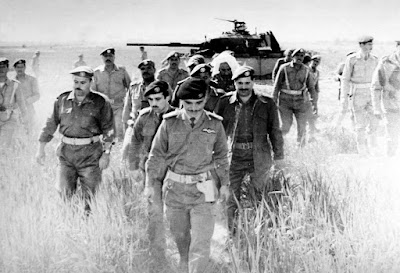King Hussein after checking an abandoned Israeli tank. The battle of Karameh.
After years of operating as clandestine cells, on 1 January 1965, Fatah
began sabotage activities against Israel, and this event is marked as Fatah
Day. Following the June War of 1967, the group operated from Jordanian soil,
and on 21 March 1968, it joined hands with the Jordanian army at the battle of
Karameh against Israel.
A number of versions of the Karameh battle exist. Many of these
accounts are designed to present the battle in a manner that favors Israel,
Jordan, or the Palestinians and some clearly meet the criteria for political
mythology noted earlier. Other explanations are more objective. Retired US Army
Colonel Trevor Dupuy has presented one of the best early accounts of this
battle from the viewpoint of a military historian.' Journalist John Cooley has
provided another useful description in his 1973 study of the Palestinian Arabs.
'Both of these authors based their evaluations on extensive interviews with
witnesses and participants in the battle. In more recent years, a variety of
Israeli participants have also presented their views of the fighting with a
level of candor and self-criticism that did not characterize initial Israeli
accounts. Most notable in this regard are works by Colonel Muki Betser and Colonel
Eliezer "Cheetah" Cohen. These discussions of the battle contain
aspects of Israeli self-criticism that challenge the more one-dimensional
accounts of earlier Israeli authors.
All serious descriptions of the battle agree that the
operation began in the early morning hours of 21 March 1968 when an Israeli
force of around 15,000 troops crossed the Jordan River and attacked the
guerrilla base at Karameh. Dupuy describes this force as composed of an
infantry brigade, an armored brigade equivalent, an airborne battalion, an
engineer battalion, and probably up to five battalions of supporting artillery.
Israeli jet aircraft and helicopters supported these troops. The Jordanian and
Palestinian fighters, aware of the build-up of forces in Israeli staging areas,
expected the attack and had prepared defensive positions and fortifications.
The Israelis called the Karameh attack" Operation
Inferno." Its purpose was to inflict a devastating and perhaps fatal blow
against the Palestinian resistance. In order to do this, armor-heavy Israeli
maneuver forces were to launch a frontal attack against lightly-armed
guerrillas, making full use of Israeli tactical air support. Paratroopers would
be deployed by helicopter behind Palestinian lines, in order to prevent a
guerrilla retreat and thereby ensure the death or capture of all guerrillas
operating from the Karameh base. Defeating Jordanian troops in the area was not
the central objective of the strike, but the Israeli leadership may have
recognized that any strike into Jordan risked involving them in the engagement.
The Israelis, nevertheless, may have expected the Jordanians to limit their military
response because of political differences and rivalry between the monarchy and
the Palestinian guerrillas. This assessment was later proven to be mistaken.
The Israelis faced the entire Jordanian First Infantry
Division reinforced by a significant number of tanks, probably from the 60th
Armored Brigade. Troops from the Royal Guard and two Saladin armored car
regiments were also sent to the Karameh area prior to the battle, although it
is uncertain that the latter saw any combat. In addition to perhaps 15,000
Jordanians, the attacking force faced around 300 Palestinian guerrillas. These
guerrillas were equipped with light arms, some older mortars, and only a few
anti-tank weapons, according to two Palestinian commando leaders cited in a
recent scholarly study. Jordanian troops, by contrast, had modem M-48 Patton
tanks, anti-tank weapons, and heavy artillery. The Jordanian Army, therefore,
had at least as many troops as the Israelis available for this operation and
were a quantitative match for Israeli forces in every military category except
for air support. Jordan's air force had been almost totally wiped out in the
1967 War.
The Israeli attackers by all accounts ran into difficulties
throughout the operation. The Jordanian Army carried out a well-prepared
defense of the area around Karameh and provided artillery support to the
guerillas at the Karameh base itself. Against this unexpectedly tough
resistance, Israeli casualties were heavier than expected. Additionally, many
of the Palestinians, after engaging in fierce resistance, were able to escape
through the surrounding Israeli paratroopers who had been inserted by
helicopter to help envelop the guerrillas. The Palestinian escape was made
under an unexpectedly heavy curtain of ground fog. The Israelis began breaking
off from the battle in the early afternoon after they had destroyed the Karameh
base and all of the guerrillas had been killed, captured, or had withdrawn. The
destruction of the base and infliction of a number of casualties was at least a
partial accomplishment of the mission and, with higher than expected casualties
of their own, withdrawal seemed the best option. All Israeli forces had
returned to their bases in Israel and the West Bank by that evening.
While these basic facts surrounding the Karameh battle are
not usually subject to controversy, key differences nevertheless exist on many
important issues. These differences include questions about (1) the full extent
of Israeli goals involving Jordan as well as the Palestinians, (2) who planned
and directed the Israeli attack (Defense Minister Moshe Dayan or a subordinate
commander), (3) the combat effectiveness of all participants, and (4) the
extent to which Jordan applied its available military strength to resist the
Israelis. It is in the interpretation of each of these factors that the concept
of political myth becomes relevant.


No comments:
Post a Comment